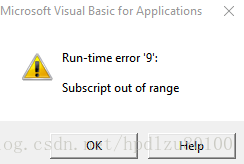Today, in order to implement a seemingly simple function, it turned out that it took me nearly 3 hours to debug the VBA code, and I still haven’t finished a cup of coffee since I drank it in the morning.
Among them, encountered a “Runtime-error ‘9’” : Subscript out of range error, which delayed a lot of time.

Problem code:
With workbooks(fileName).VBProject
For Each objVbc In .VBComponents
Select Case objVbc.Type
Case 1, 2, 3
.VBComponents.Remove .VBComponents(objVbc.Name)
Case Else
With objVbc.CodeModule
.DeleteLines 1, .CountOfLines
End With
End Select
Next
End WithSolutions:
That’s the problem
workbooks(fileName).VBProjectThis sentence. No error will be reported after modification to the following code:
Modified code:
Dim wkBook As Workbook 'VBA code (modules and worksheets) used to delete the delivery file.
Dim objVbc As Object 'Defining a VBA Component in a delivery file (VB Component)
Set wkBook = GetObject(Filename)
'Remove VBA codes from delivery files (users do not need to see these codes)
With wkBook.VBProject
For Each objVbc In .VBComponents
Select Case objVbc.Type
Case 1, 2, 3
.VBComponents.Remove .VBComponents(objVbc.Name)
Case Else
With objVbc.CodeModule
.DeleteLines 1, .CountOfLines
End With
End Select
Next
End With
———————————————————————————————————-
| Subscript out of range (Error 9) |
Elements of arrays and members of collections can only be accessed within their defined ranges. This error has the following causes and solutions:
You referenced a nonexistent array element. The subscript may be larger or smaller than the range of possible subscripts, or the array may not have dimensions assigned at this point in the application. Check the declaration of the array to verify its upper and lower bounds. Use the UBound and LBound functions to condition array accesses if you’re working with arrays that are redimensioned. If the index is specified as a variable, check the spelling of the variable name. You declared an array but didn’t specify the number of elements. For example, the following code causes this error:
|
Visual Basic doesn’t implicitly dimension unspecified array ranges as 0 – 10. Instead, you must use Dim or ReDim to specify explicitly the number of elements in an array. You referenced a nonexistent collection member. Try using the For Each… Next construct instead of specifying index elements. You used a shorthand form of subscript that implicitly specified an invalid element. For example, when you use the ! operator with a collection, the ! implicitly specifies a key. For example, object!keyname. value is equivalent to object.item(keyname).value. In this case, an error is generated if keyname represents an invalid key in the collection. To fix the error, use a valid key name or index for the collection.
For additional information, select the item in question and press F1 (in Windows) or HELP (on the Macintosh).